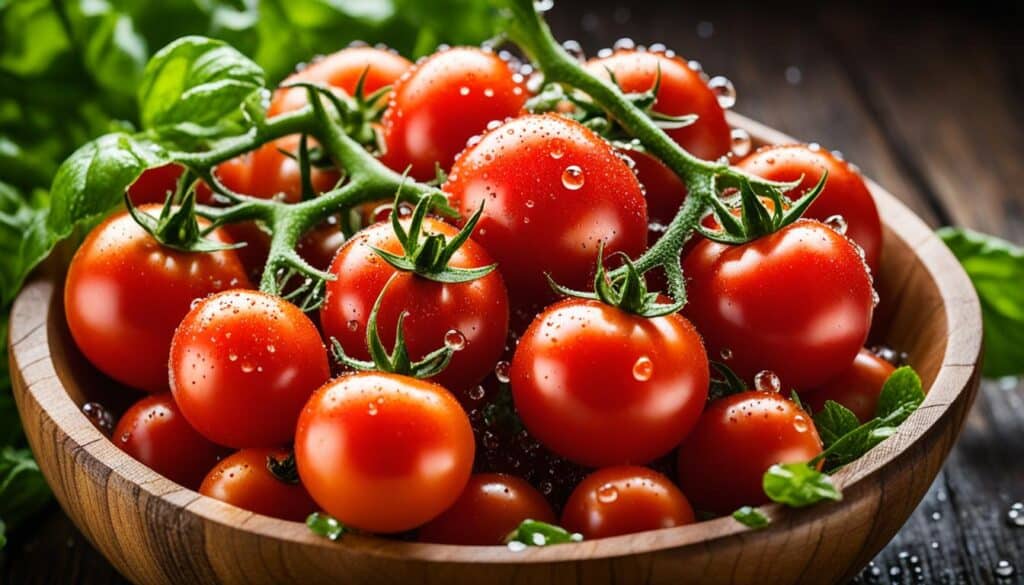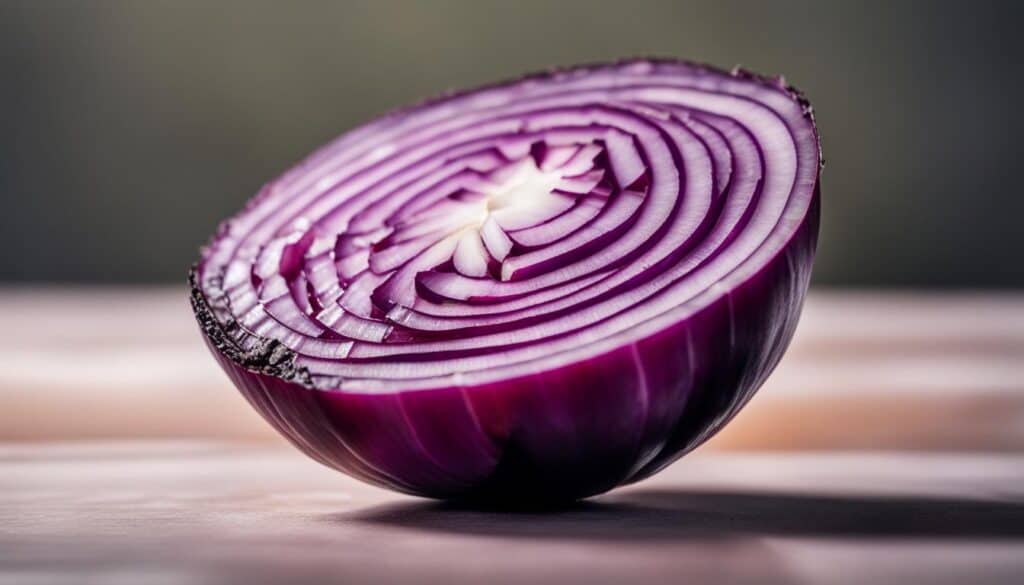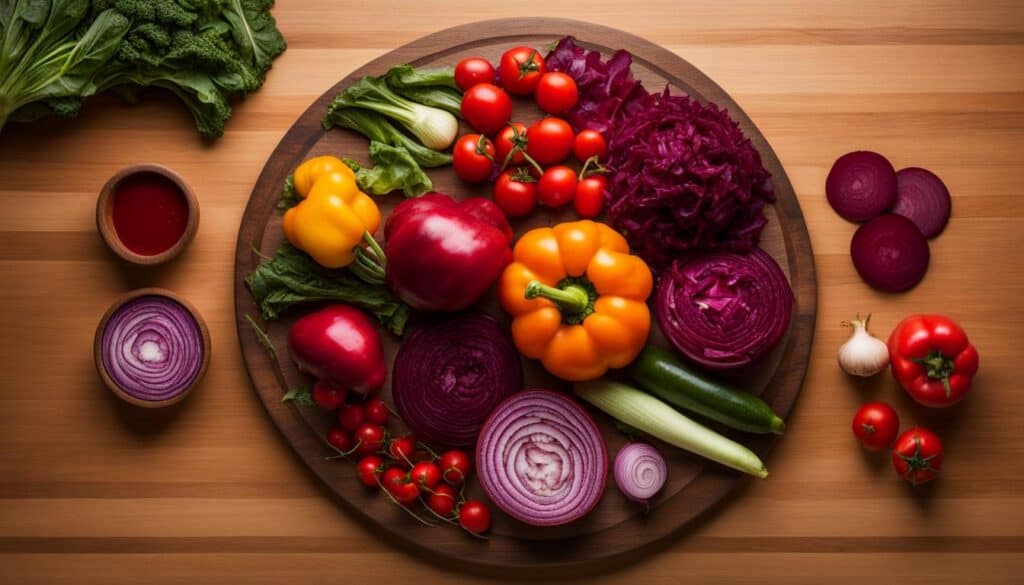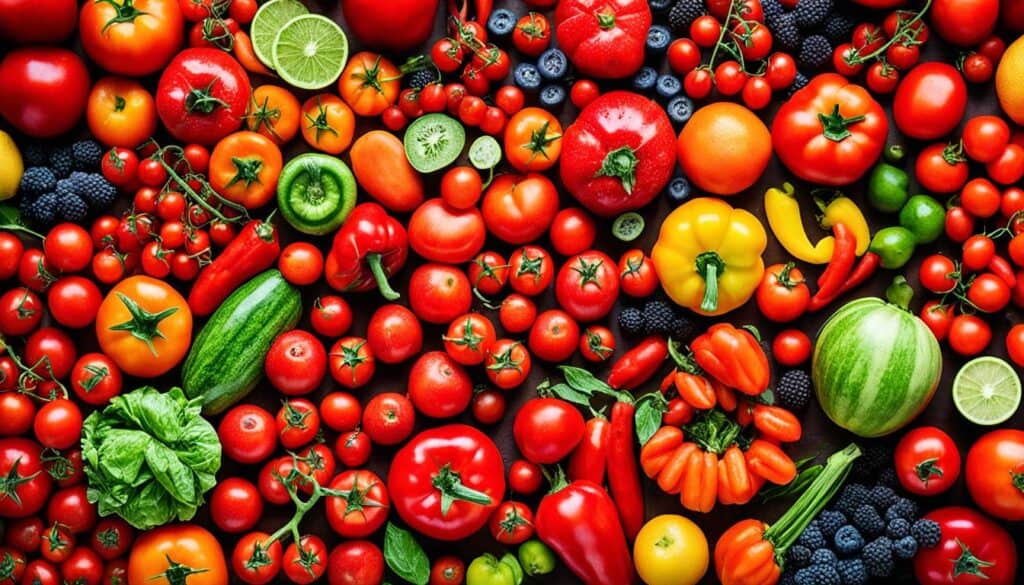Did you know that red vegetables, like tomatoes and bell peppers, can do more than just add a burst of color to your plate? These vibrant veggies are packed with nutrition and offer numerous health benefits that you may not be aware of. From reducing the risk of chronic diseases to boosting the immune system, incorporating red vegetables into your diet can have a significant impact on your overall well-being.
According to the Mayo Clinic, red vegetables may help lower the risk of diabetes, osteoporosis, and high cholesterol. The deep red colors of these vegetables indicate a higher concentration of phytonutrients, including antioxidants, vitamins, and minerals. These powerful nutrients have been shown to prevent cancer, fight chronic illnesses, and strengthen the immune system.
Two main phytonutrients responsible for the color and health benefits of red vegetables are lycopene and anthocyanin. Lycopene is an antioxidant that reduces the risk of heart disease, protects the eyes, fights infections, and potentially guards against prostate cancer and other tumors. Anthocyanins, on the other hand, protect the liver, improve eyesight, and reduce blood pressure and inflammation.
Despite these impressive benefits, the majority of adults do not consume enough red and orange vegetables, according to the National Cancer Institute. It’s time to take advantage of the nutritional power of red vegetables and discover the incredible impact they can have on your health.
Key Takeaways:
- Red vegetables, such as tomatoes and bell peppers, offer numerous health benefits.
- They are packed with phytonutrients, including antioxidants, vitamins, and minerals.
- Lycopene and anthocyanin are the main phytonutrients responsible for the color and health benefits of red vegetables.
- Red vegetables may reduce the risk of diabetes, osteoporosis, and high cholesterol.
- Despite their benefits, most adults do not consume enough red vegetables.
The Power of Beets
When it comes to red vegetables, beets are definitely a star player. These vibrant root vegetables not only add a pop of color to your plate but also offer a plethora of health benefits. Packed with essential nutrients, beets are a valuable addition to any diet. Let’s explore what makes beets so special.
Nutritional Powerhouse
Beets are considered one of the most antioxidant-rich vegetables, according to the USDA. They are a great source of potassium, fiber, folate, vitamin C, and nitrates.
| Nutrient | Amount per 100g |
|---|---|
| Potassium | 325mg |
| Fiber | 2.8g |
| Folate | 109μg |
| Vitamin C | 4.9mg |
| Nitrates | 110mg |
These nutrients not only support overall health and well-being but also contribute to specific benefits attributed to beets.
Lower Blood Pressure and Improved Athletic Performance
“Recent studies have shown that consuming beets may have a positive impact on blood pressure and athletic performance.”
In fact, research suggests that regular beet consumption may help lower blood pressure and improve blood flow due to their high nitrate content. Nitrates are converted into nitric oxide in the body, which relaxes blood vessels and promotes better circulation. This can have a positive effect on both cardiovascular health and athletic endurance.
Cooking with Beets
There are numerous ways to incorporate beets into your cooking. You can try roasting them with a heart-healthy oil for a caramelized flavor, or sautéing the beet greens, which are also rich in vitamins A, C, and K. Beets can also be juiced, but it’s important to limit consumption and mix beet juice with other fruit and vegetable juices to avoid over-consumption of nitrates.
Now that you know the power of beets, it’s time to get creative in the kitchen and start reaping the many benefits of these delicious red vegetables.
Exploring Red Cabbage
In this section, I will delve into the nutritional powerhouse that is red cabbage. Bursting with vibrant colors and a rich array of antioxidants, red cabbage is a valuable addition to any diet.
Red cabbage is known for its high anthocyanin content, which gives it its striking hue. Anthocyanins are potent antioxidants that provide protection against various diseases, including brain diseases, cancer, and cardiovascular conditions.
But the benefits of red cabbage don’t stop there. This cruciferous vegetable is also packed with essential vitamins and minerals that promote optimal health. Vitamin K, for example, plays a crucial role in blood clotting while potentially reducing cholesterol levels and oxidative stress.
Red cabbage is also an excellent source of vitamin C, known for its immune-boosting properties. It is also rich in potassium, which supports heart health, and manganese, which aids in bone health.
One of the standout features of red cabbage is its fiber content, which contributes to improved digestion and helps maintain a healthy weight. Additionally, red cabbage contains sulforaphane, an anti-inflammatory compound that may help prevent conditions like arthritis and osteoporosis.
Overall, red cabbage is a nutritional powerhouse that offers a wide range of health benefits. From antioxidants to vitamins and minerals, this vegetable has it all. To fully appreciate the wonders of red cabbage, let’s take a closer look at its nutritional profile:
| Nutrient | Amount per 1 cup (89g) of chopped red cabbage |
|---|---|
| Vitamin C | 36.6 mg |
| Vitamin K | 18.2 mcg |
| Potassium | 218 mg |
| Manganese | 0.2 mg |
| Dietary Fiber | 1.6 g |
As you can see, red cabbage is not only a feast for the eyes but also a treasure trove of essential nutrients.
Include red cabbage in your diet to reap its numerous benefits. Try incorporating it into salads, stir-fries, or even make some delicious sauerkraut. Get creative and enjoy the flavors and health-enhancing properties of red cabbage!
The Benefits of Tomatoes
Tomatoes are a staple in many kitchens, known for their vibrant red color and delicious flavor. But did you know that tomatoes also offer a wide range of health benefits? These red vegetables are not only tasty but also packed with essential nutrients that support your overall well-being.
One of the key components that gives tomatoes their bright red hue is lycopene, a powerful antioxidant. Lycopene has been linked to various health benefits, including:
- Lowering bad cholesterol levels: Lycopene has been associated with reducing LDL cholesterol, also known as “bad” cholesterol. By incorporating tomatoes into your diet, you can potentially improve your heart health and lower the risk of cardiovascular diseases.
- Preventing inflammation: Inflammation is a natural response to injury or infection, but chronic inflammation can contribute to various health problems. The lycopene in tomatoes has anti-inflammatory properties that may help reduce inflammation in the body.
- Reducing the risk of certain cancers: Research suggests that lycopene may have a protective effect against certain types of cancer, such as lung, stomach, and skin cancer. Including tomatoes in your diet regularly may help lower your risk of developing these diseases.
In addition to lycopene, tomatoes are rich in vitamins and minerals that promote overall health. Here are some of the key nutrients found in tomatoes:
| Nutrient | Benefits |
|---|---|
| Potassium | Supports heart health and helps maintain healthy blood pressure levels. |
| Vitamin B | Plays a crucial role in energy production and proper brain function. |
| Vitamin E | Acts as an antioxidant, protecting cells from damage caused by free radicals. |
| Fiber | Aids in digestion, promotes bowel regularity, and supports a healthy weight. |
With their rich nutritional profile, tomatoes can contribute to a balanced diet and support various aspects of your health. Whether enjoyed raw in a salad, cooked in a pasta sauce, or blended into a refreshing gazpacho, tomatoes are a versatile ingredient that adds both flavor and nutrients to your meals.
So, next time you’re at the grocery store, be sure to pick up some fresh, ripe tomatoes and reap the many benefits they have to offer!
Red Bell Peppers and their Nutritional Power
When it comes to red vegetables, red bell peppers are a nutritional powerhouse. These vibrant and sweet vegetables are not only delicious but also packed with essential vitamins, antioxidants, and fiber, making them a valuable addition to any diet.
One of the standout qualities of red bell peppers is their exceptional vitamin C content. In fact, red bell peppers are one of the highest sources of vitamin C among all vegetables. Vitamin C plays a vital role in supporting a healthy immune system, assisting in collagen production, and helping the body absorb iron.
But that’s not all – red bell peppers also contain a wealth of other important vitamins, such as vitamin A and the B complex vitamins. Vitamin A is crucial for maintaining good vision and promoting healthy skin, while the B vitamins contribute to overall energy production and brain function.
The nutritional benefits of red bell peppers extend beyond just vitamins. These vibrant vegetables are also rich in antioxidants, which help protect the body against harmful free radicals and reduce the risk of chronic diseases. The antioxidants found in red bell peppers have been linked to a lower risk of certain cancers, such as lung and prostate cancer.
Furthermore, red bell peppers are an excellent source of dietary fiber. Fiber plays a crucial role in maintaining digestive health and promoting regular bowel movements. Additionally, the fiber in red bell peppers can help regulate blood sugar levels and contribute to weight management by reducing food cravings and providing a feeling of fullness.
To fully understand the nutritional power of red bell peppers, take a look at the following table:
| Nutrient | Amount per 1 cup (149g) of raw red bell pepper |
|---|---|
| Vitamin C | 152% of the Daily Value (DV) |
| Vitamin A | 9% of the DV |
| Vitamin B6 | 15% of the DV |
| Fiber | 2.9 grams |
| Antioxidants | Lutein, zeaxanthin, and beta-carotene |
As you can see, red bell peppers are not only bursting with flavor but also provide a wide array of essential nutrients. So, why not incorporate these colorful gems into your daily meals and reap the many health benefits they offer?
Red Onions and their Antioxidant Benefits
When it comes to incorporating red vegetables into your diet, don’t overlook the humble red onion. These pungent bulbs not only add flavor to dishes but also offer a host of health benefits.
Red onions are rich in antioxidants, particularly flavonoids, that can help prevent oxidative damage. These antioxidants have been shown to reduce the risk of chronic diseases, including cancer, diabetes, obesity, and heart disease.
The vibrant red color of red onions comes from anthocyanins, which are powerful antioxidants that contribute to their health benefits. These anthocyanins help protect against cellular damage, inflammation, and may even have anti-tumor properties.
But the benefits of red onions go beyond their antioxidant properties. They also have antibacterial properties, promoting the growth of healthy bacteria in the gut. This can help support digestion and overall well-being.
In fact, studies have shown that red onions contain a compound called onionin, which may have anti-tumor properties. This compound has been found to potentially prevent certain types of cancers, such as ovarian and lung cancer.
Nutrition and Vitamins
In addition to their antioxidant benefits, red onions are a good source of various vitamins and minerals. Here’s a breakdown of the key nutrients found in red onions:
| Nutrient | Amount per 100g |
|---|---|
| Fiber | 1.9g |
| Vitamin C | 7.4mg |
| Vitamin B6 | 0.12mg |
| Folate | 19μg |
| Potassium | 146mg |
Red onions are also low in calories, which makes them a great addition to any diet.
There are countless ways to incorporate red onions into your meals. Whether it’s adding them to salads, sautéing them with other vegetables, or using them as a flavor base in soups and stews, red onions can add depth and nutritional value to your dishes.
So don’t forget to include red onions in your list of red vegetables. Enjoy their antioxidant benefits and enhance the flavor and nutrition of your meals.
The Importance of Including Red Vegetables in Your Diet
When it comes to maintaining a balanced and nutritious diet, red vegetables are an essential component. These vibrant and flavorful vegetables offer a host of health benefits that can contribute to overall well-being. From boosting the immune system to aiding in weight loss, red vegetables are a powerhouse of nutrients that should not be overlooked.
Red Vegetables for a Balanced Diet
Including red vegetables in your daily meals is a smart choice for achieving a balanced diet. Red vegetables such as tomatoes, red bell peppers, and beets are rich in vitamins, minerals, and antioxidants. These nutrients support various bodily functions and help maintain optimal health.
“Red vegetables offer a wide range of essential nutrients that contribute to a balanced diet. They are excellent sources of vitamins, minerals, and antioxidants that promote overall wellness.”
Red vegetables are particularly known for their high antioxidant content. Antioxidants help neutralize harmful free radicals in the body, which can reduce the risk of chronic diseases like heart disease and certain cancers. Including a variety of red vegetables in your diet ensures you’re getting a range of antioxidants to support your health.
Red Vegetables for Weight Loss
If you’re looking to shed some extra pounds, incorporating red vegetables into your diet can be beneficial. Red vegetables are low in calories, high in fiber, and rich in water content. This combination helps you feel fuller for longer, reducing the likelihood of overeating and aiding in weight management.
Fiber plays a vital role in weight loss as it promotes satiety and regulates digestion. By including fiber-rich red vegetables like red cabbage and red onions in your meals, you can maintain a healthy weight more effectively.
Red Vegetables and Antioxidants
Antioxidants are crucial for maintaining good health, and red vegetables are packed with these powerful compounds. The deep red color of these vegetables is a clear indication of their antioxidant content.
Lycopene, found in red vegetables like tomatoes, is a well-known antioxidant that has been linked to reduced risk of chronic diseases, especially cardiovascular diseases. Anthocyanins, abundant in red cabbage and red bell peppers, offer numerous health benefits, including lowering blood pressure and reducing inflammation.
Adding Color to Your Plate
Incorporating a variety of red vegetables into your meals not only provides essential nutrients but also makes your plate visually appealing. Adding vibrant reds to your dishes not only enhances flavors but also serves as a reminder to prioritize your health and well-being.
Take your meals to the next level by experimenting with colorful salads, roasted vegetables, or stir-fries. These options allow you to combine different red vegetables, maximizing their nutritional benefits and adding variety to your diet.
Make red vegetables a staple in your diet and reap the rewards of their antioxidant properties, weight loss benefits, and contribution to a balanced diet. By including a variety of red vegetables in your meals, you’re not only enhancing the nutritional value but also promoting lifelong health and well-being.
Delicious Recipes with Red Vegetables
Looking for mouthwatering recipes that feature the goodness of red vegetables? You’re in luck! I’ve got some delicious ideas to satisfy your taste buds while reaping the benefits of red vegetables. From vibrant salads to comforting soups, these recipes will make red vegetables the star of your meals.
Colorful and Nutrient-Packed Salad
Why not start with a colorful salad that combines the goodness of various red vegetables?
| Ingredients | Instructions |
|---|---|
|
|
Enjoy this vibrant salad as a refreshing side dish or a light main course. Not only will it tantalize your taste buds, but it will also provide a power-packed dose of nutrients.
Warm and Nourishing Red Vegetable Soup
On a chilly day, there’s nothing quite as comforting as a bowl of warm red vegetable soup. Let’s take a look at a simple yet flavorful recipe.
| Ingredients | Instructions |
|---|---|
|
|
This warm and nourishing soup is a perfect way to cozy up on a cool evening. The combination of flavors from the red bell peppers, tomatoes, red onions, and red cabbage will keep you satisfied and warm.
The Power of Colorful Fruits and Vegetables
When it comes to maintaining a healthy diet, it’s crucial to include a variety of colorful fruits and vegetables. Not only do they add vibrancy to meals, but they also offer a wide range of essential vitamins, antioxidants, and nutrients that promote overall well-being. Different colors in fruits and vegetables signify the presence of specific health benefits, making it even more important to incorporate a diverse array of hues into your daily intake.
Red fruits and vegetables are known for their heart-protective properties. They are rich in antioxidants and compounds like lycopene and anthocyanins, which can help reduce the risk of cardiovascular diseases and certain types of cancer. Some examples of red fruits and vegetables include:
- Red grapes
- Strawberries
- Watermelon
- Cherries
Blue and purple fruits and vegetables are packed with antioxidants called anthocyanins, which have been linked to promoting healthy aging and improving memory. Including these colorful options in your diet can provide an array of benefits. Consider adding the following to your plate:
- Blueberries
- Purple cabbage
Orange and yellow fruits and vegetables are packed with vitamins that promote eye and skin health. They are also rich in immune-boosting properties. Including these colorful options in your diet can enhance your overall well-being. Some examples include:
- Carrots
- Oranges
Green fruits and vegetables are packed with nutrients like vitamins A, C, and K, as well as antioxidants that promote eye health and help prevent various types of cancer. Adding the following to your diet can provide numerous health benefits:
- Broccoli
- Spinach
White fruits and vegetables may not be as colorful, but they offer their fair share of health benefits. These options are often rich in nutrients like potassium and contain compounds that can help lower cholesterol and blood pressure. Some examples include:
- Onions
- Mushrooms
By including a variety of colorful fruits and vegetables in your meals, you can ensure that your body receives a wide range of essential nutrients. Don’t be afraid to experiment with different colors and flavors to create a vibrant and nutritionally balanced plate.
| Fruit/Vegetable Color | Health Benefits |
|---|---|
| Red | Protects the heart and lowers the risk of cancer |
| Blue/Purple | Promotes healthy aging and improves memory |
| Orange/Yellow | Promotes eye and skin health, boosts the immune system |
| Green | Protects eye health and prevents cancer |
| White | Lowers cholesterol and blood pressure, reduces the risk of cancer |
Conclusion
In conclusion, red vegetables offer a plethora of health benefits that make them a valuable addition to your diet. By incorporating red vegetables like beets, red cabbage, tomatoes, red bell peppers, and red onions into your meals, you can enjoy their rich nutrient content and powerful antioxidant properties. These vibrant veggies help protect your heart, enhance immune function, prevent cancer, and improve overall well-being.
Furthermore, by embracing a variety of colorful fruits and vegetables, you can further amplify the advantages of a balanced diet. Red vegetables, along with other colorful produce, contribute to a vibrant plate that is not only visually appealing but also packed with essential vitamins and nutrients.
To make the most of these health-promoting ingredients, try experimenting with delicious recipes that showcase the flavors and benefits of red vegetables. From colorful salads to warm and nourishing soups, cooking with red vegetables can be a delightful culinary journey to support your well-being.










Leave a Reply